Learn how to make Chinese egg noodles with only four ingredients without any special equipment. The homemade egg noodles are chewy, springy, and perfect for making noodle stir fry and hearty noodle soup, or simply served with a sauce. {Vegetarian}
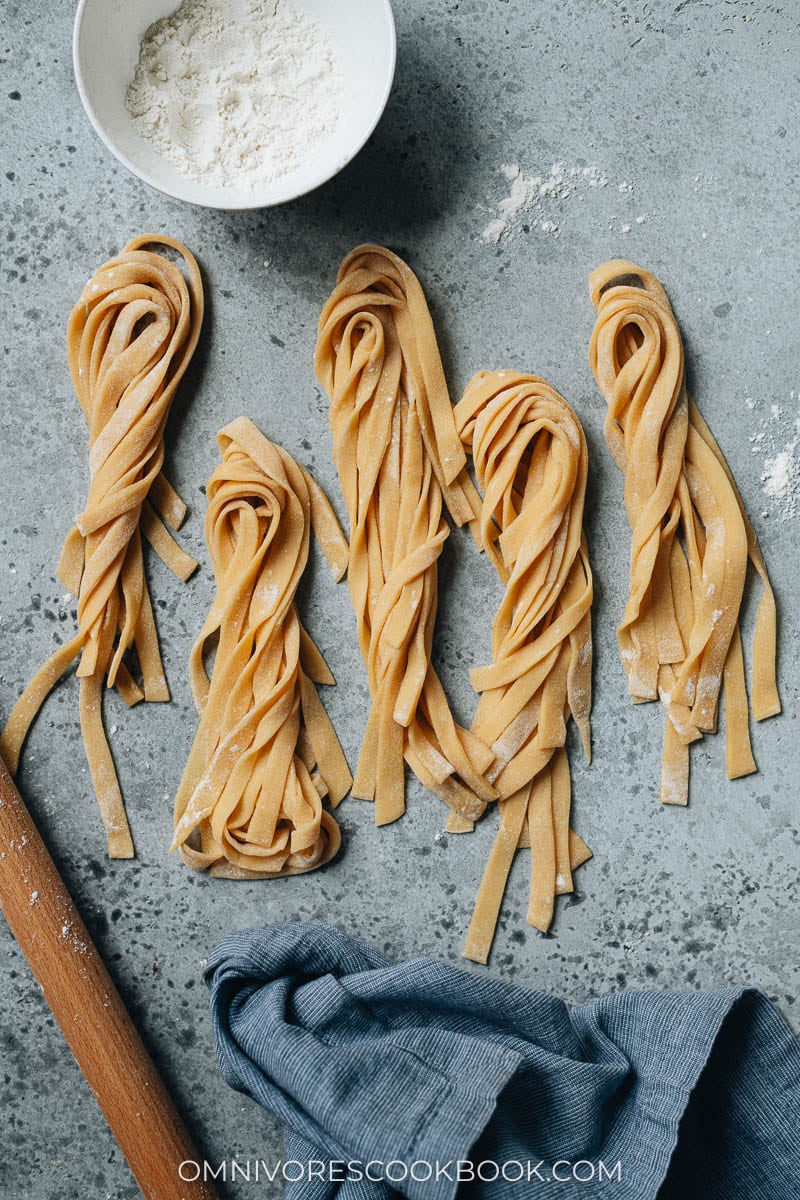
Noodles are one of the most important elements of Chinese cooking. In the busy modern age in the West, most people buy semi-fresh or dried noodles from the supermarket for a quick meal. But in China, many home cooks still hand make their fresh noodles to enjoy the best texture.
In the past, I’ve shared a few handmade noodle recipes, such as hand-pulled noodles and hand rolled noodles. Today I want to share these homemade egg noodles that have a delightfully springy and chewy texture.
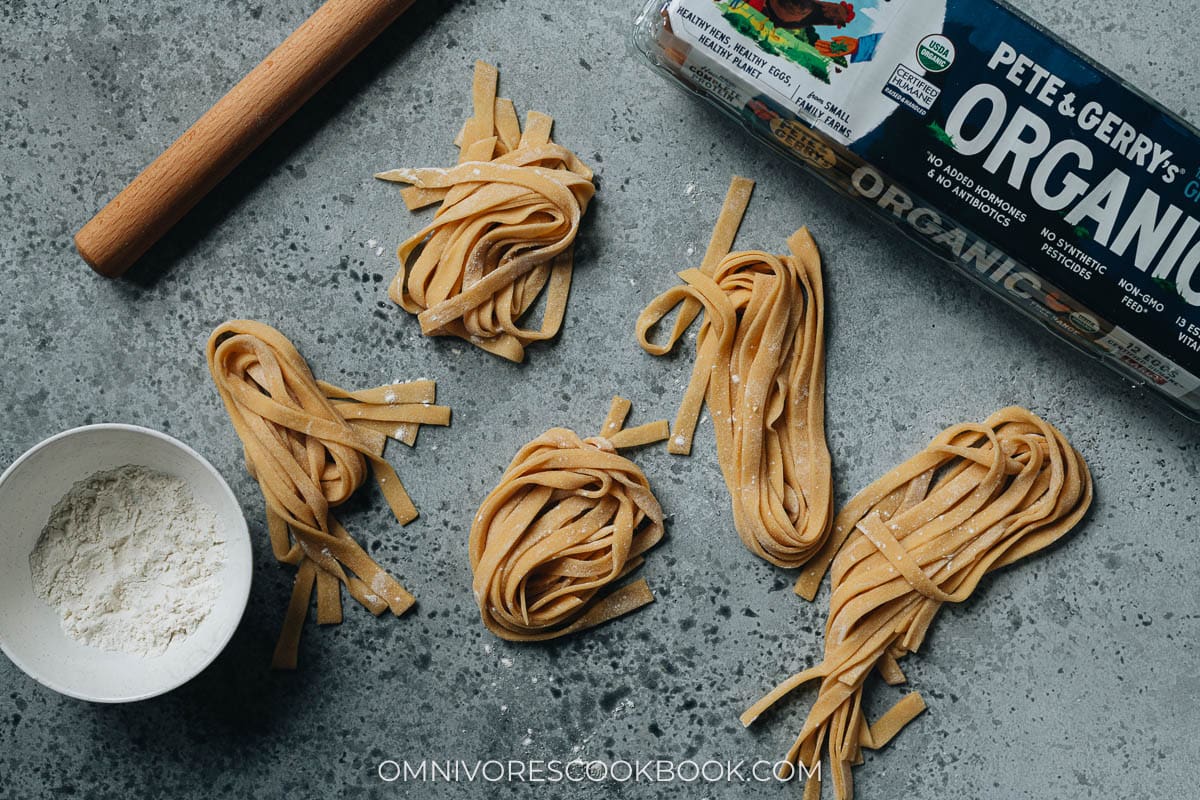
Chinese egg noodles ingredients
Chinese egg noodles use a few simple ingredients:
- All-purpose flour
- Eggs
- Salt
- Water
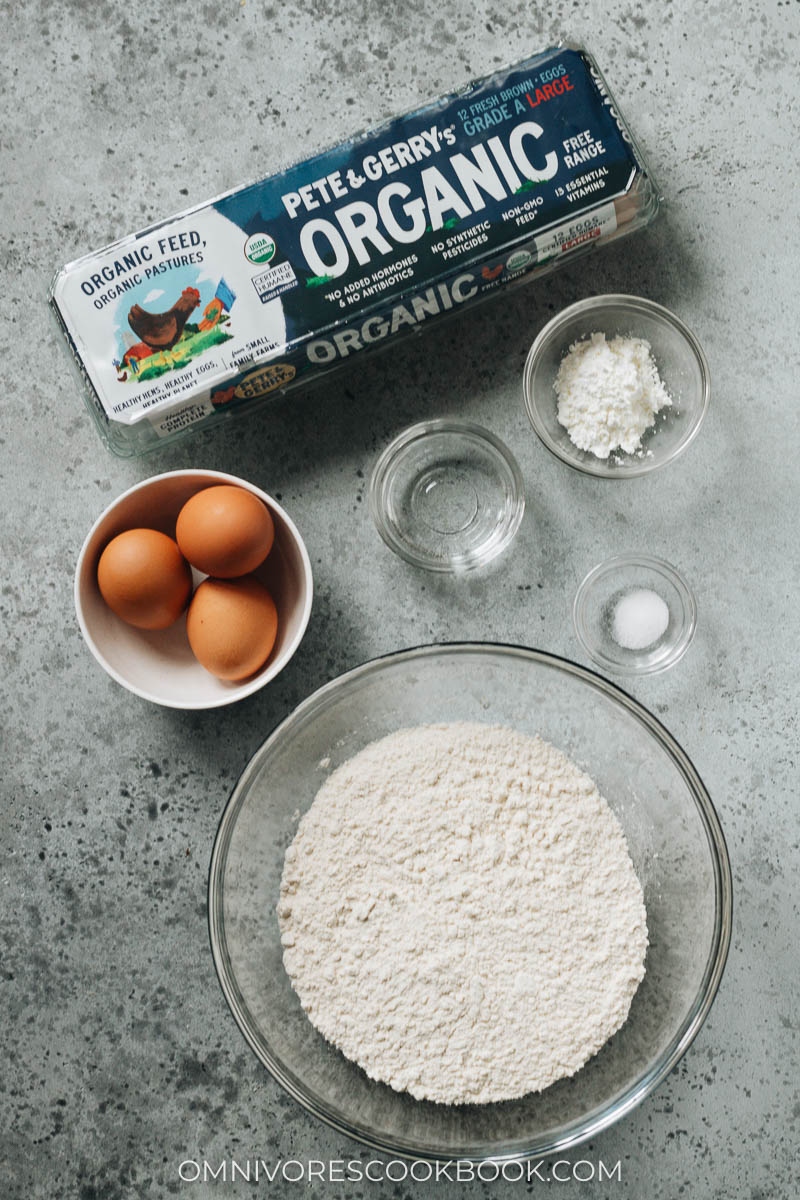
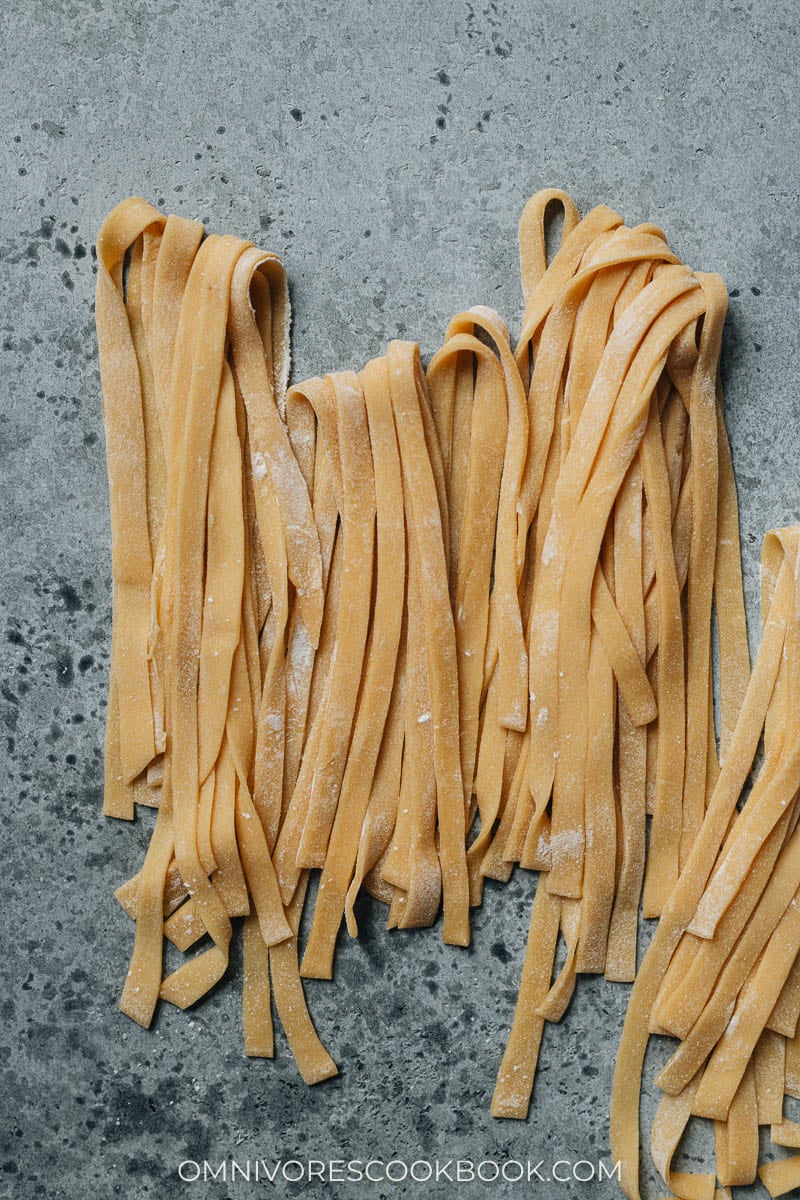
The recipe also uses cornstarch to coat the noodles, so they won’t stick together. But the cornstarch is not an ingredient in the noodles.
Just like when making pasta, it’s possible to use a pasta machine to make Chinese egg noodles. But in China, most people like to work the dough themselves so the noodles will be extra springy.
Use quality eggs
Since flour and eggs are the main ingredients, it’s important to use quality ingredients.
I love to use Pete & Gerry’s Eggs in these egg noodles. The eggs that Pete & Gerry’s sources are all from small family-run farms that offer a healthy, humane lifestyle for laying hens. Their organic free-range eggs also contain no pesticides, no added hormones, no antibiotics, and no GMOs. Their eggs have a thicker and harder shell, a big, vibrant yolk, and a richer taste.
Using their eggs, these noodles will come out with a beautiful yellow hue and a great flavor.
Water ratio
It’s hard to pinpoint an exact water ratio for homemade egg noodles, because it varies depending on the flour you use, size of the eggs and your room environment.
The 2 tablespoons of water in the recipe is a good starting point, to make a firm dough that yields chewy noodles. But you might need to slightly increase the amount of water if the dough is hard to handle, or add a little flour if the dough is too sticky.
How to make egg noodles
Making egg noodles without a pasta machine takes some time, but it’s a straightforward process.
- Mix the flour with salt, then add the eggs and water.
- Stir the mixture until dough flakes form.
- Knead until the dough is springy and the water is fully distributed.
- Rest the dough for 30 minutes, then rest it again so it’s smooth.
- Divide the dough into two pieces and work on them one at a time.
- Press and roll the dough into a small rectangle.
- Roll the dough with a rolling pin to a large thin sheet.
- Fold the dough along the long side into a roll.
- Slice the dough into noodles.
- Gently stretch the noodles to even them out.
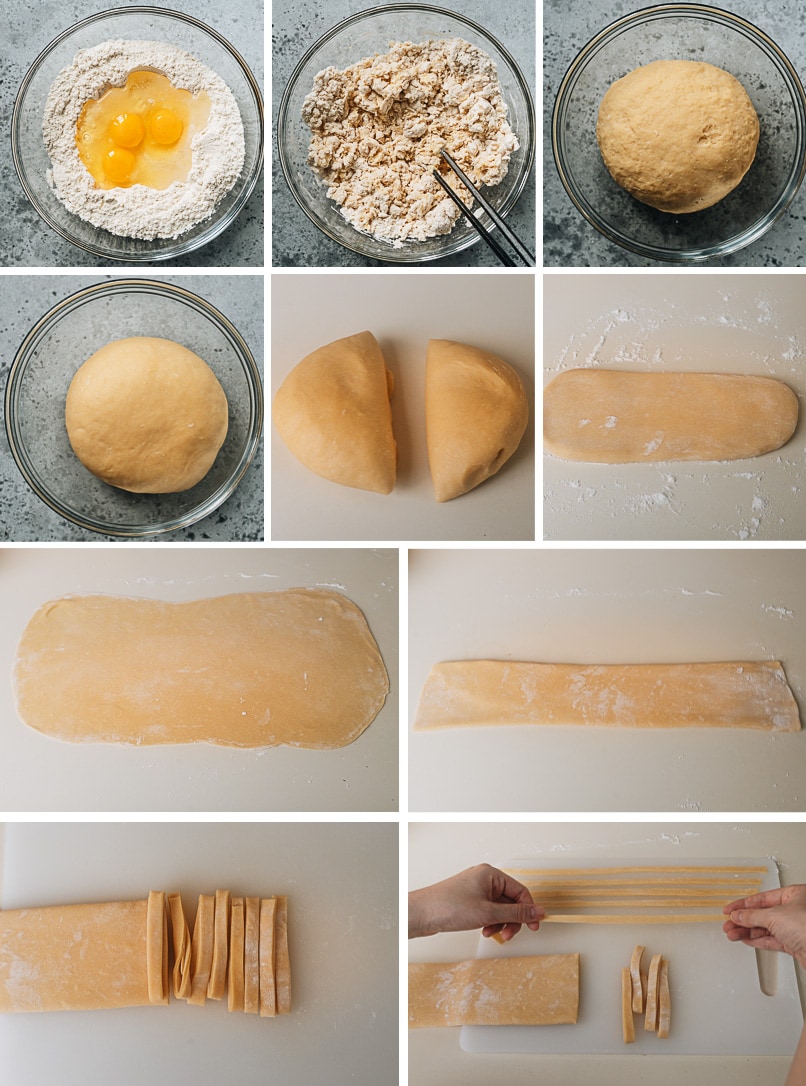
Why stretch the noodles
When making hand-rolled noodles, the stretching step is usually skipped. But since egg noodles use a pretty tough dough to create a chewy texture, it could be hard to roll the dough into a thin sheet.
I found it easier to roll the sheet until thin enough to cut the noodles. Then I prefer to work on each noodle individually to smooth it out and stretch it into a thinner shape, so it has the perfect texture.
Remember, the thickness of the noodles will almost double once you boil them. Keep that in mind when you decide whether or not to stretch the noodles.
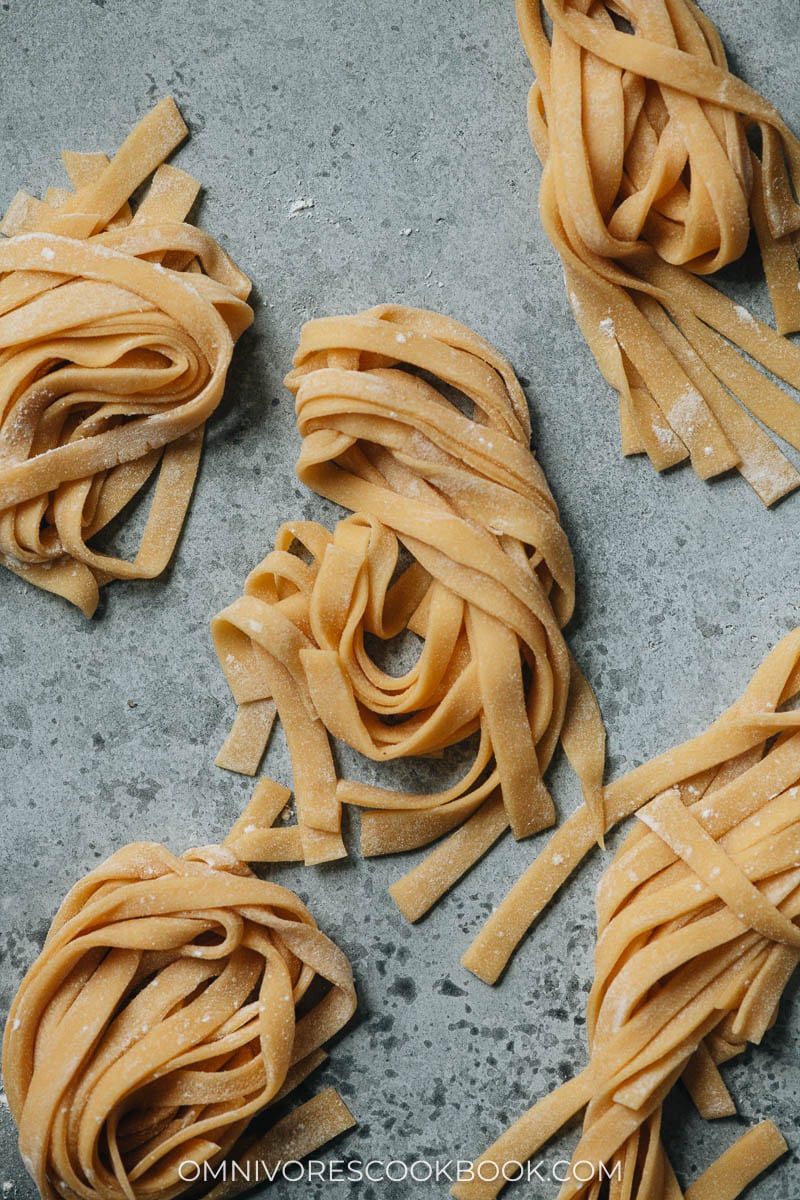
How serve homemade egg noodles
Homemade egg noodles have a lovely chewy texture and a mild taste. You really don’t need a ton of ingredients to enjoy these noodles.
Sesame noodles are one of my favorite ways to use homemade noodles. The nutty sauce and a touch of chili oil make these noodles shine.
You can serve the egg noodles with a sauce:
You can also make fried noodles:
Another great way is to make noodle soup:
How to store egg noodles
You can prepare these egg noodles ahead of time and serve them for your Chinese New Year dinner party.
If you make these noodles the day you plan to serve them, you can seal them in a bag and store them in the fridge.
If you are not going to cook the noodles immediately, it’s best to freeze the noodles right after you make them to preserve their texture. To boil the frozen noodles, the method is the same and you do not need to thaw them before boiling.
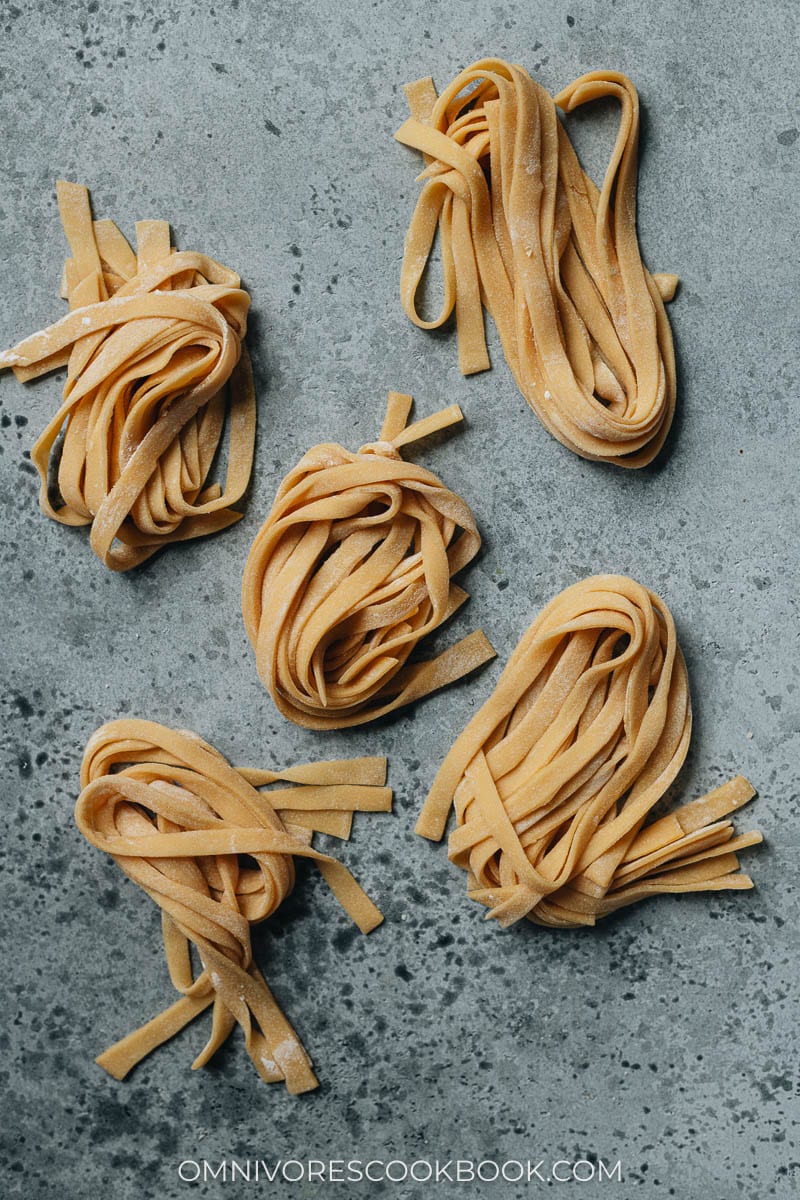
Afterthoughts
Homemade egg noodles are quite special. You can use them as a weekend project to enjoy your favorite noodle dish, or serve them during Chinese New Year to symbolize longevity. No matter whether you’re making them into your favorite fried noodles or serving them with a simple sauce, a good meal is guaranteed!
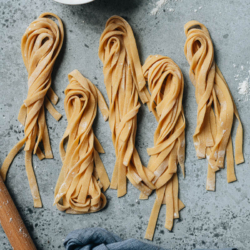
Homemade Egg Noodles (egg noodles)
Learn how to make Chinese egg noodles with only four ingredients without any special equipment. The homemade egg noodles are chewy, springy, and perfect for making noodle stir fry and hearty noodle soup, or simply served with a sauce. {Vegetarian}
Servings: 4 to 6 servings
Ingredients
- 300 g (2 cups) all-purpose flour (*Footnote 1)
- 3 Pete & Gerry’s large eggs
- 2 tablespoons (30 ml) cold tap water
- 1/4 teaspoon salt
- Cornstarch (for coating the noodles)
Instructions
-
Add the flour and salt into a large mixing bowl. Mix well and make a well in the center. Add the eggs and the cold water into the well. Stir to mix everything together until shaggy dough flakes form. There should be little dry flour in the bowl and the dough flakes should be semi-soft without being sticky. If there is too much dry flour in the bowl, add 1 more tablespoon of cold water and stir to mix again.
-
Press the dough flakes together with your hands until the dough is mostly formed. The dough can be slightly sticky to the hands, but still quite firm.
-
Transfer the dough onto a clean work surface. Knead with hands until the water is evenly absorbed and a springy dough forms, 10 to 15 minutes. If the dough sticks to the work surface too much, dust the surface with all-purpose flour and keep kneading. If the dough is very dry and hard to work with, wet the surface of the dough with some water and knead until the water is fully mixed in.
-
Place the dough into the mixing bowl and cover with plastic wrap. It’s OK if the surface of the dough is not super smooth. Let rest for 30 minutes.
-
Once the dough is rested, gently knead the dough again for 1 to 2 minutes so it’s very smooth. Let the dough rest, covered, for another 10 to 20 minutes to relax it.
-
Divide the dough into halves. Cover up the half you’re not working with.
-
Dust the work surface with cornstarch and place one piece of dough on top. Press and roll the dough into a small rectangle shape. If the dough springs back and is very hard to knead, you can cover it up and let it rest another 10 to 20 minutes to relax it.
-
Then roll the dough with a rolling pin into a very large thin sheet, about 1/8” (3 mm) thick, 18” long and 10” wide.Dust the top of the dough with cornstarch again. Fold the dough up along the long side, twice, into a long roll. Then slice the dough into noodles depending on the width you prefer, 1/8” for thin noodles, 1/4” wide for medium noodles, or 3/4” wide for wide noodles. Use your hands to gently pull each noodle so the length increases by 1/3. Set aside and work on the rest of the noodles in the same way.
-
Lightly dust all the noodles with cornstarch and fluff the noodles to coat evenly.
-
Now you can boil the noodles and serve them directly. If not used immediately, store the noodles in a sealed bag or container in the fridge for up to a day, or in the freezer for up to 3 months. You don’t need to thaw the noodles before boiling.
-
To boil the noodles, bring a large pot of water to a boil. Boil the noodles for 2 minutes or so, or until fully cooked through (the cooking time depends on the thickness of the noodles you make).
Notes
- If you used cups instead of grams to measure the flour, it’s very likely that you will need more water. Because it’s easy to pack in more flour when using a measuring cup.
Nutrition
Serving: 1serving, Calories: 187kcal, Carbohydrates: 32g, Protein: 7.5g, Fat: 2.9g, Saturated Fat: 0.8g, Cholesterol: 93mg, Sodium: 133mg, Potassium: 78mg, Fiber: 1.1g, Sugar: 0.3g, Calcium: 20mg, Iron: 2mg

